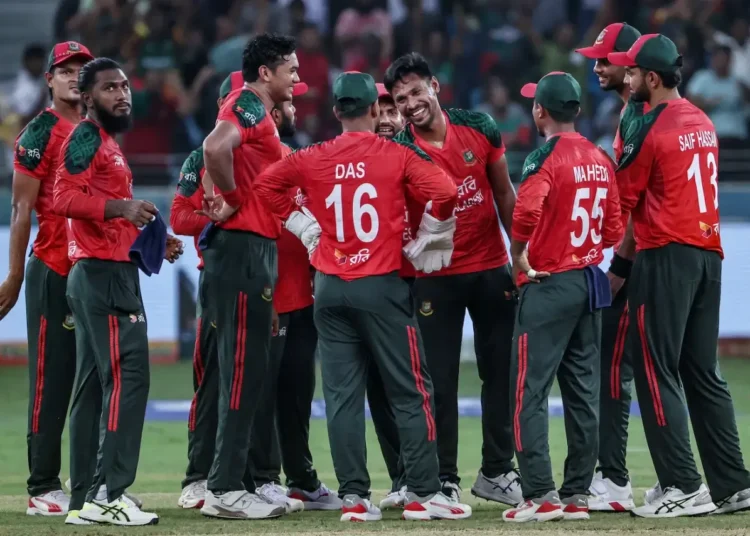Bangladesh face a massive test in the Asia Cup 2025. The Tigers meet India, the reigning T20 champions, in a high-pressure fixture that could decide a finalist spot. Head coach Phil Simmons has urged his side to enjoy the moment and play with freedom. His words reflect a changing mindset within the Bangladesh camp.
The last time these two sides met in a series, India dominated. In October 2024, Bangladesh were crushed 3-0, chasing mammoth totals of 221 and 297. That tour ended a chapter, and within three days Simmons took over as head coach. He immediately began reshaping their style, focusing on aggression and flexibility.
Now, Bangladesh carry momentum after a strong win over Sri Lanka. Simmons wants his team to focus on the bigger picture. He insists that the goal is the trophy, not just one upset victory. Litton Das, as captain, has bought into this approach, encouraging players to trust their instincts.
The rivalry adds more fire. India and Bangladesh have a history that extends beyond statistics. From the 2007 World Cup shock to the Nidahas Trophy drama, every contest brings hype. On Wednesday, Bangladesh want to convert hype into performance. The mission is not only survival but to prove that they can stand toe-to-toe with the world’s best.
Bangladesh vs India Rivalry: Beyond the Numbers
The head-to-head record reads a crushing 16-1 in India’s favour. But cricket between these two has always gone beyond numbers. It is the narrative of rivalry that makes every clash special. Bangladesh shocked India in the 2007 World Cup, sending ripples through the cricketing community. That game planted the seeds of belief.
In 2015, the two sides met again in a fiery World Cup quarter-final in Melbourne. Emotions ran high, and Bangladesh made the world sit up. Then came the unforgettable Bengaluru thriller in the 2016 T20 World Cup. Bangladesh fell short by one run, but the drama confirmed the rivalry’s global attention.
The 2018 Nidahas Trophy final was perhaps the most heated. Dinesh Karthik’s last-ball six silenced Bangladesh, but also proved their growing competitiveness. Since then, matches have been marked by both tension and respect.
Key Flashpoints in the Rivalry
Simmons has chosen to embrace this hype rather than ignore it. He believes hype can fuel performance. His words—“we are going to ride on the hype”—mirror a bold, fearless approach. Bangladesh are not only playing cricket, they are chasing pride and recognition. And for them, India remains the ultimate marker of progress.
Several iconic moments define India vs Bangladesh clashes. The Dhoni-Mustafizur shoulder barge in 2015 stirred controversy. The last-ball heartbreak in 2016 remains unforgettable for fans. And the Nidahas Trophy six in 2018 has become part of cricket folklore.
Each game adds a new flavour to this heated rivalry. Fans expect drama every time these two teams meet. This narrative of hype, tension, and surprises makes the Asia Cup clash even more exciting.
Phil Simmons and the New Bangladesh Approach
When Simmons took charge, he wanted a change in mindset. Bangladesh had been guilty of playing too safely in T20s, focusing on building platforms. Simmons ripped up that playbook. He encouraged aggression, independence, and adaptability. Players were told to trust their skills and instincts.
Litton Das has aligned perfectly with Simmons’ philosophy. His captaincy style gives freedom to young players. This has allowed cricketers like Saif Hassan to return and shine. Against Sri Lanka, Saif struck a superb 61, proving the impact of faith and opportunity.
Simmons has also introduced flexibility in selection. Players rotate based on conditions and match-ups. Nurul Hasan was replaced by Mahedi Hasan against Sri Lanka for tactical reasons. Rishad Hossain was swapped for Shoriful Islam to add pace. Every change has been driven by strategy, not emotion.
Bowling, too, has been carefully managed. Taskin Ahmed, Mustafizur Rahman, and Shoriful are rotated to avoid overwork. Younger bowlers like Nahid Rana are guided with detailed feedback for future growth. This workload management system is a big shift from the past.
Tactical Depth and Player Roles
Simmons has also leaned on assistant coach Mohammad Salahuddin, known for his domestic expertise. Together, they have built an environment of confidence and trust. The results may be inconsistent, but the direction is clear: Bangladesh want to be fearless, bold, and flexible.
Under Simmons, no player is guaranteed a permanent role. Selections are tactical, based on opponents and conditions. This approach makes the XI harder to predict and harder to break into. Players must remain sharp and adaptable, which Simmons views as essential in modern T20 cricket.
Conclusion: Can Bangladesh Turn Hype into Reality?
Bangladesh enter this Asia Cup clash with belief and flexibility. They know India is are favourite, but Simmons has built a team that refuses to play scared. His message is clear: play with freedom, enjoy the game, and trust your skills.
The rivalry adds spice, but the stakes add pressure. A win here could push Bangladesh closer to the final, a huge achievement for a team still rebuilding. More importantly, it would confirm that their new approach is working.
Simmons has reminded his players that they are not here for small wins. They are here for the trophy. His ability to keep players grounded while allowing them freedom might prove decisive.
India remains strong, but Bangladesh no longer see itself as an outsider. They see themselves as contenders. And in T20 cricket, belief can often tilt the scales. The question is simple: can Bangladesh ride the hype and finally deliver against their most formidable rivals?






